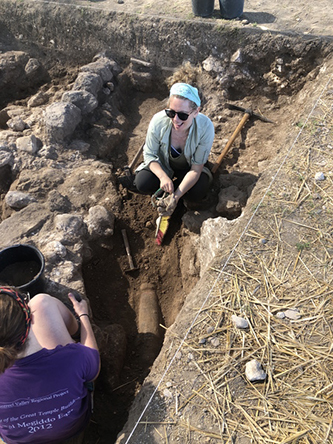Tow Professor Karen B. Stern Gabbay to Provide Deeper Insight into Ancient Judaism Through Study of Millenia-Old Graffiti
Sept. 20, 2019
The history professor will conduct research beyond the borders of Israel, expanding our knowledge of the reach and impact of Jewish culture in antiquity.

Karen B. Stern Gabbay on a dig in Israel
Associate Professor of History Karen B. Stern Gabbay has built a formidable reputation in her field studying the wall drawings and other artifacts of ancient Jewish communities. Her research has taken her underground into the caves of ancient mortuary complexes in Israel to study inscriptions carved into the walls of burial sites—some of them more than two millennia old. Her recent monograph, Writing on the Wall: Graffiti and the Forgotten Jews of Antiquity (Princeton University Press, 2018), analyzes patterns and contents in the long-neglected medium of graffiti to reconsider the daily lives of Jews throughout the ancient world.
Stern Gabbay’s work has been featured on NPR, The Daily Beast, and in The Guardian. It has also garnered her a 2019 Tow Professorship Award, which will enable her to pursue these subjects further.
The history professor’s interest was first piqued by graffiti in a synagogue discovered at Dura-Europos, an ancient Roman outpost in today’s Syria. She went on to do more extensive research at Beth She’arim, a necropolis in northwestern Israel, near Haifa.
“My examinations of associated drawings and writings revealed significant if otherwise unknown information about how some Jews, including traders, sailors, slaves, and women cloth-sellers, performed acts of writing and drawing in order to pray, to commemorate the dead,” says Stern Gabbay, who also found material on participation in civic activities, including attendance of sports and theater competitions. She said of her previous monograph, Inscribing Devotion and Death: Archaeological Evidence for Jewish Populations in North Africa (Brill, 2007), that she “reassessed known evidence to advocate for the inclusion of North African Jews into broader debates about ancient Jewish cultures and in discussions of North African history more generally.”
Stern Gabbay plans to use her Tow Professorship to work on a third book tentatively titled “Judaism: An Object History.” She says it “builds on the methods and subjects of previous projects to offer a new type of historiography of ancient Judaism.” Specifically, the Tow Professorship, made possible by The Tow Foundation, will fund her research in the archaeological sites of Sardis and Aphrodisias in Turkey, in the catacombs of Rome and Naples in Italy, and the archives of the Vatican museum in Rome and the Louvre in Paris.
Students in a class taught by Professor Stern Gabbay should expect to spend as much time out of the classroom as in; she is a big advocate of experiential learning. She has her students study at cemeteries, museums, archives, even obelisks like Cleopatra’s Needle in Central Park. They not only write papers but lead groups related to their research. She said of the response, “even the most seemingly detached students are surprised by their immediate engagement in the activity.”






